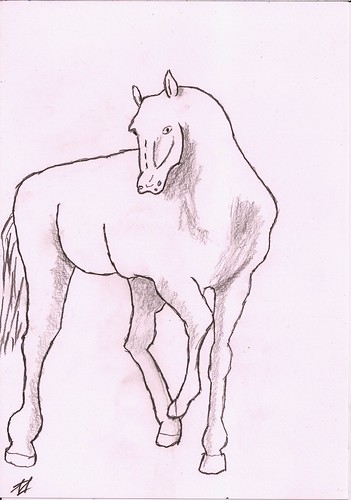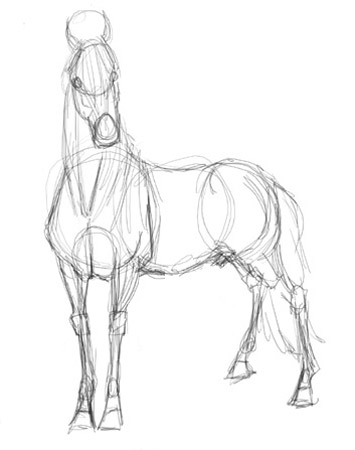Horse Pictures to Draw Biography
Source(Gogle.com.pk)Don Quixote is a 1955 sketch by Pablo Picasso of the Spanish literary hero and his sidekick, Sancho Panza. It was featured on the August 18-24 issue of the French weekly journal Les Lettres Françaises in celebration of the 350th anniversary of the first part of Cervantes’s Don Quixote. Made on August 10, 1955, the drawing Don Quixote was in a very different style than Picasso’s earlier Blue, Rose, and Cubist periods.
Contents [hide]
1 Details
2 The original
3 Black-and-white color
4 Symbolism
5 Today
6 Notes
7 References
Details[edit]
The painting is of Don Quixote de la Mancha, his horse Rocinante, his squire Sancho Panza and his donkey Dapple, the sun, and several windmills. The bold lines, almost scribbles, that compose the figures are stark against a plain, white background. The figures are almost laconic and deformed, and are dramatic. Sancho Panza looks up at a tall, elongated, gaunt Don Quixote, who, in return, gazes forward. Don Quixote and Rocinante stand nobly, but have a somewhat tired air. The figure, painted with heavy strokes, seems to have been changed multiple times as Picasso painted Don Quixote's torso, arms and shoulder. "The knight's head, capped by what would be Mambrino's helmet, is connected to his shoulders by a neck made with a single, thin line, and it sports a pointed nose and a long, equally thin goatee. He carries a lance in his right hand and the reins and a circular shield apparently in his left. Rocinante is the bag of bones described by Cervantes. Panza appears to the left, a black mass vaguely defining his round body, and sitting on Dapple who has a long, wiry neck and thin, long ears. Little attention seems to have been paid to Panza sketched in the same vein, perhaps because Don Quixote is the center of attention. Though the two figures seem to be standing still, the drawing is full of movement; the lines are exuberant and the overall effect is catchy and one of bright humor."[1]
The original[edit]
In July 2010, Georgian art critics, including Dali Lebanidze, scientist of the G. Chubinashvili National Center of Art History Research and Fixation, claimed to have found the long-lost original drawing the design that appeared in the French magazine in a family’s home in Tbilisi. The family received the drawing from a relative abroad and believed that it was a print of the iconic image.
While the graphic today is generally depicted in a stark black and white, the image that appeared in the weekly journal was in a gray tone. The Don Quixote in the Georgian family’s home was in a blue-green paint, which would have created the gray tones of the journal print. Attention caught by the unusual color and the apparent old age of the frame, Lebanidze decided to examine it more closely.
He soon came to the conclusion that the supposed print was in fact the original drawn by Picasso, saying, “The placement of ink on the paper, the incredible energy of the artist’s manner, the complete freedom of lines that reflects inner emotion of the artist – all indicated to the fact that it was the original. It is impossible to achieve such freedom, to repeat or copy such spontaneous character of the picture.”[2]
However, aside from the gushing possibility the original has been found at long last, nearly two years after the above-referenced "discovery", no independent scientific, forensic or critical judgment has been published nor has a high-resolution image been released by Lebanidze or any official of the National Center of Art History Research and Fixation. Furthermore, a search of the website (gch-centre.ge) returns not a single reference to the iconic Picasso ink-wash, lending credibility to the assumption that this "discovery" is apocryphal and no more valid than the unproven claim that the original Quixote drawing has been locked inside a St. Denis Church basement safe in France since its creation in 1955.
Black-and-white color[edit]
If the Don Quixote found in Tbilisi is in fact the original, several interesting questions about the intended coloring and shading are raised. In black and white, the image is stark, simple, and evenly bold. The lighter, bluish ink tone adds a complexity to the picture with different shades and differences in bold and lighter lines. In this version, Don Quixote, Rocinante, the windmill standing between Don Quixote and Sancho Panza, and the ground lines are darker and bolder, emphasizing those features. Everything else, including Sancho Panza, the other windmills, and the sun, are lighter and more seem to fade into the background.
Symbolism[edit]
This complexity is not seen in the grey journal print, nor in the currently popular black-and-white versions. But if this shading is deliberate, then new interpretations of Don Quixote can be inferred. According to Lebanidze, the dark elements of the drawing represent what has been transformed by Don Quixote’s mind from the everyday to the mythical: himself and his horse into a heroic knight, a windmill into a giant, and the ground into the world of his imagination. The other subjects have been left in the sphere of reality, a world more distant and less visible to Don Quixote.[3]
Today[edit]
Today, however, the black-and-white version has become the more popular image of Don Quixote. It is widely recognized as one of the most prominent depictions of the legendary figure who is a popular figure in art. Picasso’s drawing is also used as the logo of the Cervantes Society of America, whose “purpose is to advance the study of the life and works of Miguel de Cervantes through the promotion of communication and cooperation among its members, through the publication of reviews of books and articles and reports on pedagogical approaches to Cervantes's work, through descriptions of research currently in progress by members, through discussion at annual meetings, and through such other means as may tend to deepen and broaden understanding of Cervantes and his works.”[4] [Link in Notes and in References is dead 2013-07-03. Try http://www.h-net.org/~cervant/]
Notes[edit]
Jump up ^ http://www.h-net.org/~cervantes/csa/artics92/lo_re.htm
Jump up ^ Dali, Lebanidze. "Picasso's "Don Quixote" Found in Georgia." Georgia Today 16/07/2010, Print.
Jump up ^ Dali, Lebanidze. "Picasso's "Don Quixote" Found in Georgia." Georgia Today 16/07/2010, Print.
Jump up ^ Wyszynski, Mike. "Cervantes Society of America." 2009. Web. 02 Mar. 2011. <http://users.ipfw.edu/jehle/cervante/csapage.htm>.
References[edit]
Dali, Lebanidze. "Picasso's "Don Quixote" Found in Georgia." Georgia Today 16/07/2010, Print.
Virtual Solutions. "Don Quixote by Pablo Picasso at Picasso Art." Picasso Art Prints - Pablo Picasso Prints and Painting Information Source. 2005. Web. 09 Mar. 2011. <http://www.picasso-art.com/picasso_don_quixote.html>.
Wyszynski, Mike. "Cervantes Society of America."2009. Web. 02 Mar. 2011. <http://users.ipfw.edu/jehle/cervante/csapage.htm>. [Dead link 2013-07-03. Try http://www.h-net.org/~cervant/]
[hide] v t e
Pablo Picasso
Periods
Blue (1901–1904) Rose (1904–1906) African (1907–1909) Cubism (1910–1919)
Pablo picasso 1.jpg
Lists of works
1889–1900 1901–1910 1911–1920 1921–1930 1931–1940 1941–1950 1951–1960 1961–1970 1971–1973
Major works
Child with a Dove (1901) Femme aux Bras Croisés (1902) The Old Guitarist (1903) Portrait of Angel Fernández de Soto (1903) Portrait of Suzanne Bloch (1904) The Actor (1904) Family of Saltimbanques (1905) Garçon à la pipe (1905) Les Noces de Pierrette (1905) Boy Leading a Horse (1906) Les Demoiselles d'Avignon (1907) Le pigeon aux petits pois (1911) Bottle, Glass, Fork (1912) Three Musicians (1921) Reading the Letter (c.1921) The Three Dancers (1925) Vollard Suite (1930-37) La Lecture (1932) Le Rêve (1932) Nude, Green Leaves and Bust (1932) Nude in a Black Armchair (1932) Jeune Fille Endormie (1935) Guernica (1937) The Dream and Lie of Franco (1937) Woman in Hat and Fur Collar (1937) The Weeping Woman (1937) Maya with Doll (1938) Dora Maar au Chat (1941) Bull's Head (1942) The Charnel House (c.1944-48) Tete de femme (Dora Maar) (1950s) Baboon and Young (1951) Massacre in Korea (1951) Sylvette (1954) Don Quixote (1955) Las Meninas (1957) Jacqueline (1961) Chicago Picasso (1967)
Partners
Fernande Olivier (1904 to 1911) Eva Gouel (1912 to her death in 1915) Olga Khokhlova (married 1918, to her death in 1955, mother of Paulo) Marie-Thérèse Walter (1927 to 1935, mother of Maya) Dora Maar (1936 to 1944) Françoise Gilot (1944 to 1953, mother of Claude and Paloma) Geneviève Laporte (during the 1950s) Jacqueline Roque (married 1961 to Picasso's death 1973)
Family
Paloma Picasso José Ruiz y Blasco
Colleagues and friends
Carlos Casagemas Georges Braque Julio González Max Jacob Henri Matisse Jaime Sabartés
Patrons and biographers
Gertrude Stein Etta and Claribel Cone Douglas Cooper John Richardson Daniel Kahnweiler Ambroise Vollard
Museums
Château Grimaldi (Antibes) Museu Picasso (Barcelona) Musée Picasso (Paris) Museo Picasso Málaga (Malaga)
Films
Van Renoir tot Picasso (1948) Visit to Picasso (1949) Guernica (1950) Picasso (1955) The Mystery of Picasso (1956) The Adventures of Picasso (1978) Surviving Picasso (1996) Picasso: Magic, Sex, Death (2001)
Plays by Picasso
Desire Caught by the Tail c. (1941) The Four Little Girls c. (1947-1948)
Poetry by Picasso
Picasso's poetry
See also
Fundación Picasso Blanquita Suárez
Wikimedia
Wiktionary-logo-en.svg Picasso at Wiktionary Wikiquote-logo.svg Picasso at Wikiquote Commons-logo.svg Picasso at Commons Wikinews-logo.svg Picasso at Wikinews
Categories: 1955 drawingsPablo PicassoDon Quixote
Navigation menu
Create accountLog inArticleTalkReadEdit
Search
Navigation
Main page
Contents
Featured content
Current events
Random article
Donate to Wikipedia
Interaction
Help
About Wikipedia
Community portal
Recent changes
Contact page
Toolbox
What links here
Related changes
Upload file
Special pages
Permanent link
Page information
Data item
Cite this page
Print/export
Create a book
Download as PDF
Printable version
Languages
Edit links
This page was last modified on 4 July 2013 at 02:02.
Text is available under the Creative Commons Attribution-ShareAlike License; additional terms may apply. By using this site, you agree to the Terms of Use and Privacy Policy.
Wikipedia® is a registered trademark of the Wikimedia Foundation, Inc., a non-profit organization.
Horse Pictures to Draw for Kids Black and White to Color Funny Hd Wallpapepr Images Pics
Horse Pictures to Draw for Kids Black and White to Color Funny Hd Wallpapepr Images Pics

Horse Pictures to Draw for Kids Black and White to Color Funny Hd Wallpapepr Images Pics
Horse Pictures to Draw for Kids Black and White to Color Funny Hd Wallpapepr Images Pics
Horse Pictures to Draw for Kids Black and White to Color Funny Hd Wallpapepr Images Pics

Horse Pictures to Draw for Kids Black and White to Color Funny Hd Wallpapepr Images Pics
Horse Pictures to Draw for Kids Black and White to Color Funny Hd Wallpapepr Images Pics

Horse Pictures to Draw for Kids Black and White to Color Funny Hd Wallpapepr Images Pics
Horse Pictures to Draw for Kids Black and White to Color Funny Hd Wallpapepr Images Pics

Horse Pictures to Draw for Kids Black and White to Color Funny Hd Wallpapepr Images Pics

Horse Pictures to Draw for Kids Black and White to Color Funny Hd Wallpapepr Images Pics

Horse Pictures to Draw for Kids Black and White to Color Funny Hd Wallpapepr Images Pics
Horse Pictures to Draw for Kids Black and White to Color Funny Hd Wallpapepr Images Pics

Horse Pictures to Draw for Kids Black and White to Color Funny Hd Wallpapepr Images Pics

Horse Pictures to Draw for Kids Black and White to Color Funny Hd Wallpapepr Images Pics
Horse Pictures to Draw for Kids Black and White to Color Funny Hd Wallpapepr Images Pics


No comments:
Post a Comment